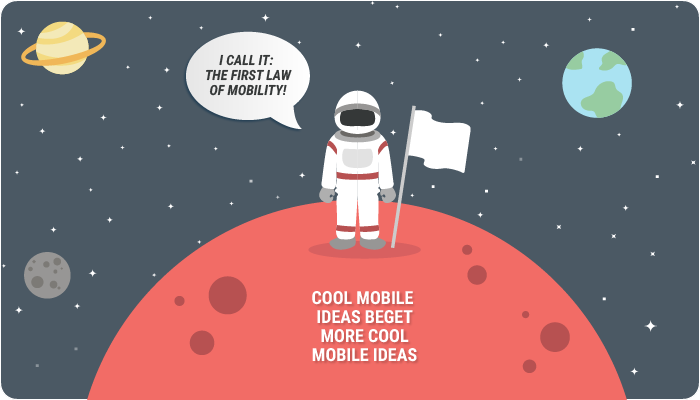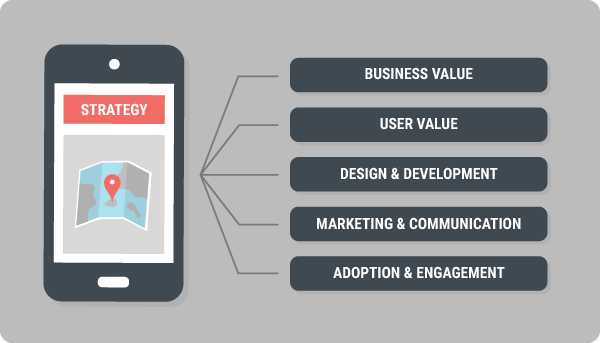Explore the Mobile Landscape
Learning Objectives
- Describe how organizations can achieve success with mobile.
- Define the mobile app portfolio.
- List some challenges facing organizations that want to develop mobile apps.
- Describe the components of a mobile strategy.
Our Mobile Future
It’s a brave new world, isn’t it? Mobile technology has advanced by leaps and bounds over the past decade, and now we’re all walking around with tiny, powerful computers in our pockets. Our smartphones can do astonishing things—shoot HD video, translate foreign languages, take dictation, monitor heart rates. They even have artificial intelligence! The future is definitely here. (Sadly, still no flying cars, though.)
And this is just the beginning. Mobile will continue to shape our future because we’ve reached a tipping point. According to a recent Pew Research Survey, a whopping 78% of Americans own a smartphone. And the worldwide numbers are just as staggering: Ericsson’s Mobility Report predicts that global smartphone ownership will reach 70% by 2020.

Because mobile devices are so pervasive, technology and mobile apps have touched every facet of our lives, and the enterprise world is no exception.
The Evolution of Enterprise Mobility
We’ve come a long way with mobile. Remember back when having a mobile-friendly website was considered the ultimate mobile solution? Those days are ancient history, and it’s largely due to the rapid pace of innovation in the consumer space.
Apps are a way of life now, and our behaviors and expectations are different. We spend our time in slick, easy-to-use apps like Facebook, Instagram, and Spotify. We gravitate toward experiences that embrace the uniqueness of mobile: experiences that are smart, personalized, and contextual.
And we’ve all heard the success stories. Look at companies like Uber and Lyft. They transformed ground transportation services and disrupted their entire industry. Sure, it’s an inspiring case study. But unfortunately, mobile success stories of that magnitude are few and far between.
That’s because most companies aren’t innovating fast enough to keep up with consumer behaviors and expectations. According to Forrester’s study CMOs: Own Your Customers to Own Mobile, 44% of the companies surveyed state that their mobile services are just a scaled-down version of their online initiative. That simply isn’t good enough anymore.
Where We Go Wrong
These days, too many companies approach mobility by saying, “We need an app!” And to be fair, you probably do. But why? And for whom? Will it help your customers or employees in some specific way? Will it delight them? Will it help your company achieve an important business objective?

Developing apps without a clear strategy is like steering a ship without a rudder. So don’t rush into any big mobile projects. First establish a direction. Before your organization sets off on a mobile journey, you need to answer some important questions and come up with a comprehensive game plan. Only then can you unlock the transformative power of mobility.
The Path to Transformation
Think of mobile as a catalyst—it gives you the opportunity to completely reimagine your customer’s experience. You get to look at their journey holistically and identify moments where you can swoop in and meet their need or solve a problem right from their mobile device.
Maybe you assist them with a purchasing decision while they’re at a store. Maybe you provide a timely instructional video upon their first use of your product. What are the stages of your customer’s life cycle, and how can mobile intersect with each of those stages?

But it’s not enough to think about your customer’s experience. Consider your entire organization. How do you connect to your employees? How do you connect to your partners? What’s their journey?
You probably guessed that a single mobile app can’t revolutionize your interactions with customers, employees, and partners. And you’re right. To become a mobile enterprise, it’s imperative that you deliver multiple mobile solutions. Those solutions become part of a holistic app ecosystem, part of a larger customer and employee story.
Progress Can Be Incremental
At this point you’re probably thinking, “OK, Salesforce. That sounds nice, but how the heck do we grow an entire app ecosystem?” Fair question. It’s just like growing anything else, really. You start small. You plant a seed.
Apps for Employees
If you’re at the beginning of your mobile journey, we suggest you roll out an app for your employees, like the Salesforce mobile app. It’s easy to do—no coding required. With your employees collaborating and accessing CRM data from their mobile devices, your organization takes its first step toward mobile transformation.
And it doesn’t stop there. Perhaps you see such positive results from the Salesforce app rollout that you build a couple of employee apps, like one for sharing ideas and one for logging tickets.
Apps for Customers and Partners
Then someone has a great concept for a partner app, and you implement that, too. And then after mobility has proven to be so beneficial, your company decides to develop a custom app for your customers...maybe a loyalty rewards app.
Great Things Start Small
Well, that escalated quickly. And it’s because mobile is a generative force in any organization. Let’s call it The First Law of Mobility: cool mobile ideas beget more cool mobile ideas. What starts as a single star in the mobile sky becomes an entire constellation of apps. And from such humble beginnings, your mobile app ecosystem is born.

At Salesforce, we refer to this ecosystem as a mobile app portfolio. And growing your mobile app portfolio is the key to achieving real mobile transformation.
Every Path Has Obstacles
There’s a reason why most companies haven’t achieved mobile transformation. And here’s why: It’s hard! Seriously. These are just a few of the challenges many organizations face when it comes to their mobile initiatives:
- No clear direction or strategy
- Lack of analytics and research to inform mobile development
- Not enough executive support or funding
- Scarcity of mobile expertise and resources
- Legacy systems and data silos that prevent integration
- Concerns about security and compliance
- Indecision about mobile technologies, tools, and platforms
Luckily, these obstacles aren’t insurmountable. Many of them can be tackled by developing a mobile strategy that guides your organization on its mobile journey. And—spoiler alert!—Salesforce has a platform and tools that can help you hurdle some of these obstacles, accelerating your progress on the path to success.
Why You Need a Mobile Strategy
So what exactly is a mobile strategy? Well, if your organization is on a mobile journey, then your mobile strategy is the map that plots your path and keeps you headed in the right direction.

There are five basic components that make up a comprehensive mobile strategy:
- Business value: To succeed with mobile, your mobile initiatives must be aligned with your organization’s business objectives. How can you establish your goals and measure success?
- User value: You won't win over mobile users unless your solution delivers moments of real value. How do you obtain research that helps you identify the needs and goals of your users so you can design the right mobile solutions?
- Design and development: There are a lot of moving parts to any development project. How do you create a plan that accounts for the various tools, technologies, resources, and processes necessary for the job?
- Marketing and communication: Whether you’re building solutions for your customers or employees, it’s necessary to get the word out. How can you market your new offering to users? How can you onboard and train them?
- Adoption and engagement: A mobile app isn’t a success unless it’s embraced by users and delivering value to your organization. How do you measure adoption and drive engagement?
Your Mobile Journey Begins Here
In the rest of this module, you learn what it takes to create a comprehensive mobile strategy so that your company can become a mobile enterprise.
Even if you’re not a decision maker in your organization, you’ll walk away with a solid understanding of the components of a mobile strategy, as well as the ability to identify the key players and start the right conversations about mobility. Then you’ll be well on your way to mobile transformation.

So let’s get ready to hit the road! Every successful journey starts with preparation, and that’s what we’ll talk about next.